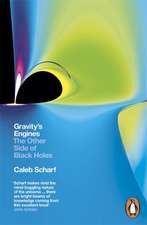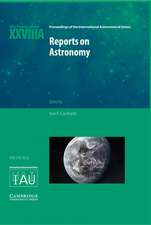Close Binaries in the 21st Century: New Opportunities and Challenges
Editat de Alvaro Gimenez, Edward Guinan, Panagiotis Niarchos, Slavek Rucinskien Limba Engleză Hardback – 14 dec 2006
There are many binary star systems whose components are so close together, that they interact in various ways. Stars in such systems do not pass through all stages of their evolution independently of each other; in fact their evolutionary path is significantly affected by their companions. Processes of interaction include gravitational effects, mutual irradiation, mass exchange, mass loss from the system, phenomena of extended atmospheres, semi-transparent atmospheric clouds, variable thickness disks and gas streams.
The zoo of Close Binary Systems includes: Close Eclipsing Binaries (Detached, Semi-detached, Contact), High and Low-Mass X-ray Binaries, Cataclysmic Variables, RS CVn systems, Pulsar Binaries and Symbiotic Stars. The study of these binaries triggered the development of new branches of astrophysics dealing with the structure and evolution of close binaries and the interaction effects displayed by these exciting objects. Close Binaries are classic examples of the fundamental contribution that stellar astrophysics makes to our general understanding of physical processes in the universe.
Ground-based and space surveys will discover many new close binaries, which were previously unknown. In the future, new approaches will also be possible with highly efficient photometric searches looking for very shallow eclipses, such as those produced by Earth-like extra-solar planets.
Contributions to this conference covered the latest achievements in the field and reflected the state of the art of the dynamically evolving area of binary star research.
| Toate formatele și edițiile | Preț | Express |
|---|---|---|
| Paperback (1) | 658.55 lei 6-8 săpt. | |
| SPRINGER NETHERLANDS – 19 oct 2010 | 658.55 lei 6-8 săpt. | |
| Hardback (1) | 614.87 lei 38-44 zile | |
| SPRINGER NETHERLANDS – 14 dec 2006 | 614.87 lei 38-44 zile |
Preț: 614.87 lei
Preț vechi: 768.59 lei
-20% Nou
Puncte Express: 922
Preț estimativ în valută:
117.66€ • 123.41$ • 97.95£
117.66€ • 123.41$ • 97.95£
Carte tipărită la comandă
Livrare economică 28 martie-03 aprilie
Preluare comenzi: 021 569.72.76
Specificații
ISBN-13: 9781402050268
ISBN-10: 1402050267
Pagini: 412
Ilustrații: IX, 401 p.
Dimensiuni: 210 x 297 x 23 mm
Greutate: 1.29 kg
Ediția:2006
Editura: SPRINGER NETHERLANDS
Colecția Springer
Locul publicării:Dordrecht, Netherlands
ISBN-10: 1402050267
Pagini: 412
Ilustrații: IX, 401 p.
Dimensiuni: 210 x 297 x 23 mm
Greutate: 1.29 kg
Ediția:2006
Editura: SPRINGER NETHERLANDS
Colecția Springer
Locul publicării:Dordrecht, Netherlands
Public țintă
ResearchCuprins
Close Binaries in the 21 st Century: New Opportunities and Challenges.- The Brave New World of Binary Star Studies.- Multisite, Multiwavelength Studies of the Active Cool Binary CC Eri.- Late-type X-ray Emitting Binaries in the Solar Neighborhood and in Star Forming Regions.- Analysis of Extra-Solar Planetary Transits Using Tools from Eclipsing Binaries.- Photometric Studies of Twelve Deep, Low-mass Ratio Overcontact Binary Systems.- Updated UBV Light-Curve and Period Analysis of Eclipsing Binary HS Herculis.- The Period Variation of V839 Oph.- Investigation of Times of Minima of Selected Early-Type Eclipsing Binaries.- Photometric Studies of Bright Southern Binary Systems: ? Cra and ? Ori.- Photometric Solution of the O-type Eclipsing Binary V1007 Sco.- First results of the Central-East-South European Binary Star Study Group (CESEB).- Spot Modelling of ? Andromedae.- Chromospheric Activity and Orbital Solution of Six New Late-type Spectroscopic Binary Systems.- The Near-Contact System V387 Cygni: BVRI Photometry and Modelling.- Monitoring Secular Orbital Period Variations of Some Eclipsing Binaries at the Ankara University Observatory.- The W UMa-type Stars Program: First Results, Current Status and Perspectives.- A Mechanism for Producing Short-Period Binaries.- Evolutionary Status of Late-type Contact Binaries: Case of a 1.2 + 1 M ? Binary.- Wind Ionization Structure of the Short-Period Eclipsing LMC Wolf-Rayet Binary BAT99-129: Preliminary Results.- Masses and Radii of Low-Mass Stars: Theory Versus Observations.- Light-Time Effect in the Eclipsing Binaries GO Cyg, GW Cep, AR Aur and V505 Sgr.- X-ray Observations of Binary and Single Wolf-Rayet Stars with XMM-Newton and Chandra.- Libration Points in Schwarzschild’s Circular Restricted Three-Body Problem.-Symbiotic Stars in the Context of Binary Evolution and Metallicity.- Properties of Components in Contact Systems.- On (? ? ?) and ( ? ?)-Type Relations for Close Binaries.- Radiation Pressure and Surface Gravity of Close Binaries: First Results from Observational Data Analysis.- The Spatial Distribution of W UMa-Type Stars.- Modeling the 2004.5 Brightening of the Contact Binary V839 Oph.- First Photometric Observations and Preliminary Results of Binaries FO Aurigae and V1025 Herculis.- Monitoring Possible Light-Time Effect in the Orbital Period of Some Eclipsing Binaries at the Ankara University Observatory.- Distributions of Geometrical and Physical Parameters of Contact Binaries.- Some Thoughts on Pulsation and Binarity.- Active Longitudes in Close Binaries.- Enhanced Activity in Close T Tauri Binaries.- Modelling Eclipsing Binaries with Dense Spot Coverage.- Orbital Period Changes and Long Term Luminosity Variation in Active Binary CG Cyg.- Short Time-Scale Variability in the Light Curve of TW Draconis.- X-ray Emission from the Pre-Main Sequence Systems FU Orionis and T Tauri.- A Search for Pulsating, Mass-Accreting Components in Algol-Type Eclipsing Binaries.- HD172189, a Cluster Member Binary System with a ? Scuti Component in the Field of View of COROT.- Eclipsing Binaries with Possible Light-Time Effect.- Eccentric Eclipsing Binary YY Sagittarii.- Photospheric Abundance Peculiarities in RS CVn Binaries.- Possible Light-Time Effect in the Eclipsing Binary System TY Boo.- Preliminary Photometric Evidence of Starspot Umbrae and Penumbrae on Late-Type Active Stars.- Late-Type Active Stars: Rotation & Companions.- Eclipsing Binaries in Open Clusters.- Eclipsing Binaries in Local Group Galaxies.- The First DIRECT Distance to a Detached EclipsingBinary in M33.- Absolute Parameters of Early-Type Close Binaries in the LMC.- Searching for Planetary Eclipses in Open Clusters: NGC 7086.- Binaries with Total Eclipses in the LMC: Potential Targets for Spectroscopy.- Eclipsing Binary Stars in Nearby Galaxies.- EROS-II Variable Stars: Eclipsing Binaries in the EROS Microlensing Surveys.- First Results from ROTES: The ROtse Telescope Eclipsing-binary Survey.- Planets and Planet-Sized Binaries from the OGLE Transit Survey.- Eccentricities of Planets in Binary Systems.- A Three Body Solution for the DI Her System.- Common Proper Motion Search for Faint Companions Around Early-Type Field Stars — Progress Report.- The Asiago Extrasolar Planet Transit Search.- The WASP Project and SuperWASP Camera.- X-Ray Binaries in Nearby Galaxies.- Synthesis of Line Profiles and Radial Velocity Curves for X-Ray Binary Systems.- Hot Subdwarfs in Precataclysmic Binaries.- On the Binary Nature of SS 433.- On Possible Nature of Pre-eclipse Dips in Light Curves of Semi-detached Systems with Steady-state Disks.- After the Supernova: Runaway Stars and Massive X-ray Binary Populations with Metallicity.- X-rays from the Symbiotic Star RX Pup.- Results of Optical Monitoring of Cataclysmic Variable GK Per in 2004.- Tomographic Simulations of Accretion Disks in Cataclysmic Variables — Flickering and Wind.- X1908+075: A Late O-Type Supergiant with a Neutron Star Companion.- Spectroscopy of the Candidate Pre-CV LTT 560.- The Enigmatic Behaviour of the Old Nova RR Pic.- Symbiotic Binary YY Her — Eclipses, Flares and Outbursts.- Analysis of Near Infrared Observations of the Symbiotic Mira RR Tel.- The Structure and the Partial Opacity of the Spiral Shocks on the Novalike Cataclysmic Variables.- Deductions from the Indication of Eclipses of NovaV1493 Aql.- Mapping of the Disc Structure of the Neutron Star X-ray Binary X1822-371.- The DDO Short-Period Binary RV Program.- Abundances from Disentangled Component Spectra of Close Binary Stars: An Observational Test of an Early Mixing in High-Mass Stars.- Doppler Imaging of Rapidly-Rotating M Stars.- Disentangling of the Spectra of Binary Stars — Principles, Results and Future Development.- Automated Analysis of Light Curves of OGLE LMC Binaries: The Period distribution.- Disentangling Effective Temperatures of Individual Eclipsing Binary Components by Means of Color-Index Constraining.- A Method For Eclipsing Component Identification In Large Photometric Datasets.- H? Photometry of Two Contact Binaries.- A Library of Eclipsing Binary Light-Curves: Fast Initial Parameters Estimation, and on the Uniqueness of the Inverse Problem.- On Methods for the Light Curves Extrema Determination.- LU Vel (GJ 375): A M3.5Ve Flare and Double-Lined Spectroscopic Binary.- Dense Spot Coverage and Polar Caps on SV Cam.- Doppler Images of ? Andromedae.- Future Prospects for Ultra-High Resolution Imaging of Binary Systems at UV and X-ray Wavelengths.- The Impact of CoRoT on Close Binary Research.- On the Gaia Expected Harvest on Eclipsing Binaries.- The Kepler Mission: Astrophysics and Eclipsing Binaries.- STELLA: Two New Robotic Telescopes for Binary-Star Research.- Getting SMARTS on Novae: Highlights of the Early Evolution of Nova V475 Sct.
Notă biografică
- Gimenez is Professor in Spain and Head of Department in ESA. He is President of the OC of Comm. 42 on Close Binary Stars of the IAU.
- Guinan is Professor of Astronomy and Astrophysics at Villanova University, USA
- Niarchos is Assoc. Professor of Astronomy at the National and Kapodistrian University of Athens, Greece
Textul de pe ultima copertă
An International Conference entitled "Close Binaries in the 21st Century: New Opportunities and Challenges", was held in Syros island, Greece, from 27 to 30 June, 2005.
There are many binary star systems whose components are so close together, that they interact in various ways. Stars in such systems do not pass through all stages of their evolution independently of each other; in fact their evolutionary path is significantly affected by their companions. Processes of interaction include gravitational effects, mutual irradiation, mass exchange, mass loss from the system, phenomena of extended atmospheres, semi-transparent atmospheric clouds, variable thickness disks and gas streams.
The zoo of Close Binary Systems includes: Close Eclipsing Binaries (Detached, Semi-detached, Contact), High and Low-Mass X-ray Binaries, Cataclysmic Variables, RS CVn systems, Pulsar Binaries and Symbiotic Stars. The study of these binaries triggered the development of new branches of astrophysics dealing with the structure and evolution of close binaries and the interaction effects displayed by these exciting objects. Close Binaries are classic examples of the fundamental contribution that stellar astrophysics makes to our general understanding of physical processes in the universe.
Ground-based and space surveys will discover many new close binaries, which were previously unknown. In the future, new approaches will also be possible with highly efficient photometric searches looking for very shallow eclipses, such as those produced by Earth-like extra-solar planets.
Contributions to this conference covered the latest achievements in the field and reflected the state of the art of the dynamically evolving area of binary star research.
There are many binary star systems whose components are so close together, that they interact in various ways. Stars in such systems do not pass through all stages of their evolution independently of each other; in fact their evolutionary path is significantly affected by their companions. Processes of interaction include gravitational effects, mutual irradiation, mass exchange, mass loss from the system, phenomena of extended atmospheres, semi-transparent atmospheric clouds, variable thickness disks and gas streams.
The zoo of Close Binary Systems includes: Close Eclipsing Binaries (Detached, Semi-detached, Contact), High and Low-Mass X-ray Binaries, Cataclysmic Variables, RS CVn systems, Pulsar Binaries and Symbiotic Stars. The study of these binaries triggered the development of new branches of astrophysics dealing with the structure and evolution of close binaries and the interaction effects displayed by these exciting objects. Close Binaries are classic examples of the fundamental contribution that stellar astrophysics makes to our general understanding of physical processes in the universe.
Ground-based and space surveys will discover many new close binaries, which were previously unknown. In the future, new approaches will also be possible with highly efficient photometric searches looking for very shallow eclipses, such as those produced by Earth-like extra-solar planets.
Contributions to this conference covered the latest achievements in the field and reflected the state of the art of the dynamically evolving area of binary star research.
Caracteristici
Contributions to this conference covered the latest achievements in the field and reflected the state of the art of the dynamically evolving area of binary research



















